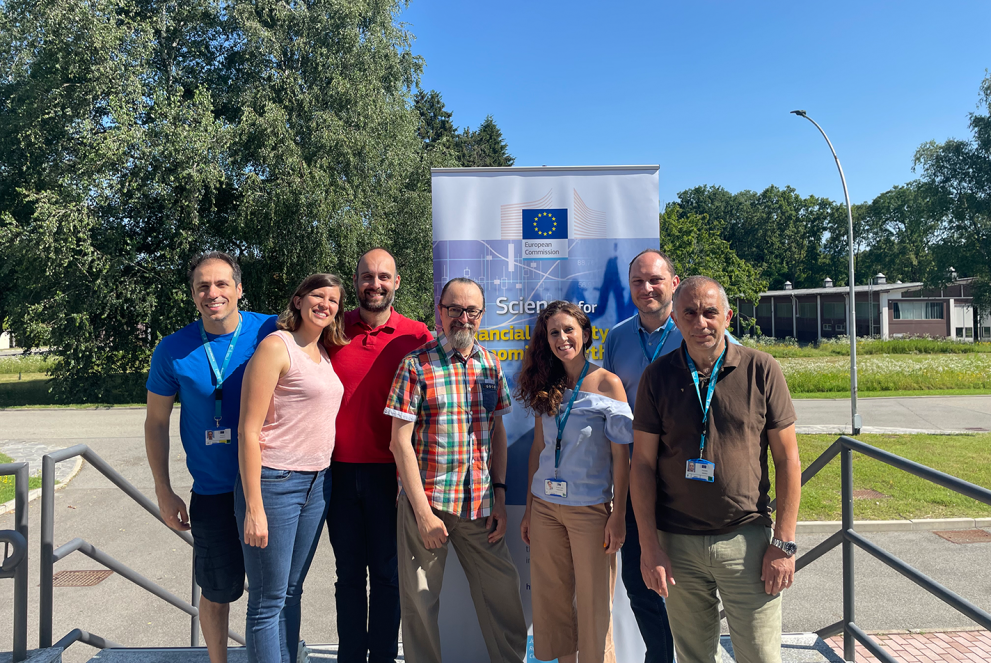
The Commission has recently put forward some legislative proposals with the aim to reinforce the EU’s financial ecosystem. Some examples are the one on the introduction of a digital version of the EU currency, the digital euro, or the one to adjust and further strengthen the existing EU bank crisis management and deposit insurance (CMDI) framework.
Same as all EC legislative proposals, these two examples are informed and supported by science. In both cases, a team of financial analysts from the JRC’s Economic and Financial Resilience Unit supported the policymakers by anticipating and analysing the possible impact that both the digital euro and the update of the CMDI framework could have on the financial system.
We spoke with the team behind those analyses to learn more about what they do and why it matters.
What does your team do?
Our team deals with risks banks face because of the many changes we are witnessing, such as climate change, digitalisation and biodiversity loss. At first sight, these topics might not seem very much related to banks and the financial system but they definitely are.
We anticipate and evaluate such risks to —ultimately— save citizens' and companies' money in crises such as the 2008 financial crisis or the recent banking turmoil.
When a crisis affects banks, it usually affects citizens and households savings or their deposits. Our research, at the very end of the day, tries to help keeping financial stability to preserve citizens’ economic well-being.
What JRC researchers are doing for tackling financial risks and all their consequences
To start with a practical example, we could take the last European Commission legislative proposal on the establishment of a digital euro. How did your research fed into it?
To put it simply, we reply to questions such as: “What might happen if the EU introduces the digital euro?"
How do we do that? We try to anticipate. We estimate, using state-of-the art economic research methods, the potential risks for the financial sector, and quantitatively assess the possible impacts. Knowing and understanding potential future risks is crucial to guarantee financial stability in the long term.
We also try to anticipate EU policy needs, and pursue our own strands of research. For example, we started investigating the risks associated with cryptocurrencies more than 5 years ago, soon after they started drawing widespread interest, so that the EU would not be caught unprepared.
Let me go deeper on this. Which are the challenges of the digital transition? How did your research contribute to the digital euro initiative?
One example of the challenges of the digital transition is the potential introduction of a digital form of our currency, the digital euro. This is a topic that has caught the attention of both policymakers and the general public.
In simple words, a digital euro is just a digital form of money issued by the European Central Bank, which is not meant to substitute but complement cash. But if not properly designed, the digital euro might pose risks to financial stability.
The role of banks might be seriously challenged if the amount of bank deposits is reduced substantially due to a transition to digital euro only wallets. In a scenario in which many people withdraw a consistent amount of money from their bank account to “convert” them and hold only digital euro, banks might have less liquidity, and therefore they might be less likely to offer credit to the economy. That is why a limit on digital euro holdings and a proposal to allow its use for retail payments only has been presented.
We have contributed to the impact assessment, at the request of the European Commission’s Directorate‑General for Economic and Financial Affairs (DG ECFIN), by checking how different holding limits could affect banks' balance sheet.
We work on various dimensions of digital finance to contribute to the objectives of the EU Digital Finance Strategy. Notably, we are developing research on stablecoins, the evolution of the digital finance ecosystem, and creating tools for the monitoring of crypto currencies.
The interactions between the emerging and decentralised digital world and the current financial system are of utmost importance in order to identify and manage challenges and risks in a timely manner. The anticipatory research we do in this context is key to preserve financial stability.

A proper design matters. Models suggest that introducing a cap on digital euro holdings would preserve financial stability, banks’ profitability, and produce small changes in the response of the economy to macroeconomic shocks.
You have just mentioned DG ECFIN. Which other services do you work with?
We collaborate with several policy DGs and EU institutions, including the European Central Bank. However, our main and long-standing partners are the Directorate‑General for Financial Stability, Financial Services and Capital Markets Union (DG FISMA) -the Commission department responsible for EU policy on financial services-, and the above mentioned DG ECFIN, -the Commission department responsible for EU policies promoting economic growth and recovery, higher employment, stable public finances and financial stability-.
These policy DGs and us deal with the same issues from different but complementary perspectives: while the policy DGs closely follow the political debate, we provide science-based quantitative assessment for policies. Together, we translate political guidance into realistic models with which we can evaluate the economic impact of planned policies.
To put it simply, we support EU policies by looking for answers to questions such the previous example 'What might happen if the EU introduces the digital euro?', or 'What should we expect if we modify the CMDI rules?'
As you mentioned the CMDI, let’s go deeper also on this case. What is the CMDI framework and why was it necessary to update it? How did you contribute to that?
During the global financial crisis of 2008, governments intervened by bailing out banks to preserve financial stability and citizens' savings. At the time, the Commission reacted quickly to protect people in the short term, but also laid the foundation for guaranteeing the long-term stability of the financial system by creating the Crisis Management and Deposit Insurance (CMDI) framework, which includes rules for handling bank failures and protecting depositors in case of bank default.
But some gaps and difficulties in its implementation had remained.
A review was needed to address these remaining issues and enable a framework that effectively shield people's and public money from bank failures. The proposal therefore focuses on medium-sized and smaller banks whose failure have often been managed using taxpayers' money instead of industry-funded safety nets, and includes other modifications to deposit protection to enhance its effectiveness.
We supported DG FISMA with a tailored analysis of different scenarios, including the potential effects of proposed policy changes in managing banking crises and protecting public finances. More specifically, we analysed a set of options to increase the protection of special categories of deposits, improve banks' access to funding, and guarantee a coherent application of the safety net tools across Member States so as to avoid losses for citizens.

The proposal improves the rules for handling bank failures, while preserving financial stability, protecting depositors, and further limiting the use of public financial resources.
You mentioned before risks associated to climate change and biodiversity loss. How can this affect our economy and what are you doing in this regard?
There is a growing consensus that climate change has become a new source of financial instability. Risks could systemically spread across the entire financial system with spillovers to the real economy.
A source of concern is also so-called “transition risk”. This stems from the potential economic losses generated by the conversion of fossil-fuels related activities or energy inefficient production processes and buildings.
To explain it with an example, a transition to a greener economy —to a ‘low-carbon’ economy— implies risks for relevant physical assets, such as, for example, a coal mine. The coal mine could eventually become “stranded” (that’s it: it loses its value, or becomes unusable, devaluated or even a liability) and result in a financial loss for its investors or even its lenders. As investors are forward-looking, a shift towards investments not prone to climate risk may occur even before the underlying physical assets become stranded. Investors may start shedding high-carbon financial assets thus triggering fast depreciations of ‘high-carbon’ financial assets, resulting in losses for the banking sector.
Also, natural disasters are already becoming more and more frequent and severe due to climate change, and they could also have a negative impact on the financial system. For example, banks could be negatively affected if their borrowers are hit by a flood or a hurricane and can't pay back their debts. In this area, we are working on identifying financial vulnerabilities and providing scientific evidence of financial risks related to climate change.
Last but not least, one of the most recent concerns is related to environmental and ecosystem degradation. By financing clients with economic activities dependent on natural assets and biodiversity, or producing large impacts on their conservation, lending institutions are exposed to risks associated with biodiversity loss. We are thus developing quantitative analyses that help identify and quantify the exposure of banks and firms to these risks.
Our research shows that addressing sustainability related challenges can be important also from a financial stability point of view, since they are a potential source of risk for individual financial institutions and for macro-financial stability.
What other topics are covered by other teams in your Unit?
Our team is part of a larger unit of about 50 scientists. Almost everyone is a researcher with a PhD in economics, finance, mathematics or physics, with extensive expertise in modelling, econometric techniques and data analysis.
Our mission is to support a wide range of policies, from macroeconomic surveillance to the screening of foreign direct investment into the EU, and from financial stability to research into resilience and wellbeing beyond GDP.
Sources
Details
- Publication date
- 28 June 2023
- Author
- Joint Research Centre




